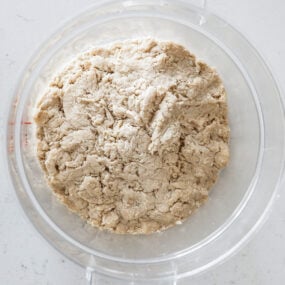

Biga Recipe
Elevate homemade bread with this simple Biga starter that adds structure, tang, and an airy crumb to pizza, ciabatta, focaccia, and more.
Ingredients
- 2 ¼ cup bread flour, 335 grams of flour
- 2/3 cup + 1 teaspoon filtered lukewarm water, 165 grams
- 1/3 teaspoon active dry yeast, 1 gram
- Olive oil
Instructions
- Add 335 grams of bread flour to a large bowl along with the water and yeast.
- Using your hands, gently mix and fold everything together to combine, which should take you about 3 to 4 minutes.
- Throughout the process of making the biga, the dough will start to become really shaggy, but that’s because it’s only hydrated at 50% and tends to be stiffer.
- Bring the shaggy dough together a bit more to form a sort of loose ball, then transfer it to a plastic container with a lid, or leave it in the bowl covered with plastic. Feel free to brush the container with a little oil.
- It can sit at a room temperature of 72° or less for 8 to 24 hours. If you are above those temperatures, I recommend letting it sit at room temperature for 4 to 6 hours, then placing it in the fridge for 24 hours, and up to 72 hours.
- After the fermenting time, use it in your pizza, ciabatta, or focaccia recipe.
Notes
Your water temperature can make or break your biga. Think of it this way: yeast is a living ingredient, and lukewarm water (between 105°F and 115°F) is key for its activation and fermentation. Slightly cooler water (between 80ºF and 82ºF) will also work, but this will result in a slower fermentation. When in doubt, opt for water that feels slightly warmer than room temperature, but never hot.
Troubleshooting a stiff biga: Biga for bread and pizza dough is meant to be on the firm side (about 50% hydration). If it feels dry and crumbly instead of cohesive, you may need to work it a little longer to fully hydrate the flour. A few extra drops of warm water can help, but don’t add too much or else it won’t hold its structure.
Rising time: Biga should ferment at room temperature (72°F or below) for anywhere between 8 and 24 hours. If your kitchen is warmer, let it rise for 4 to 6 hours, then move it to the fridge for up to 72 hours. The longer it ferments, the more flavor it develops.
How to tell when it’s ready: A well-proofed biga will look puffy, airy, and slightly domed. If you peek inside the bowl or container, you’ll notice a honeycomb-like network of bubbles—this is your sign that it’s ready to use. If you wait too long, it can become over-proofed and start to collapse.
If it didn’t rise: First check your yeast, as old or expired yeast may not proof. Also consider your water temperature. Too hot and it can kill yeast; too cold and it will ferment very slowly. If your yeast is fresh and the water temperature is right, give the biga more time—sometimes a slow fermentation just needs patience.
Make-Ahead: The biga should be made a minimum of 8 hours ahead of time. It can be left to ferment in its covered container at room temperature during this time.
How to Store: If you’re not ready to bake with it quite yet, keep the biga covered and store it at room temperature for up to 24 hours, in the refrigerator for up to 72 hours, or in the freezer for up to 3 months. Thaw the frozen biga in the refrigerator overnight, then let it come to room temperature before folding it into your dough.
Nutrition
Calories: 1019kcalCarbohydrates: 204gProtein: 34gFat: 5gSaturated Fat: 1gPolyunsaturated Fat: 2gMonounsaturated Fat: 0.4gSodium: 14mgPotassium: 291mgFiber: 7gSugar: 1gVitamin A: 6IUCalcium: 47mgIron: 3mg